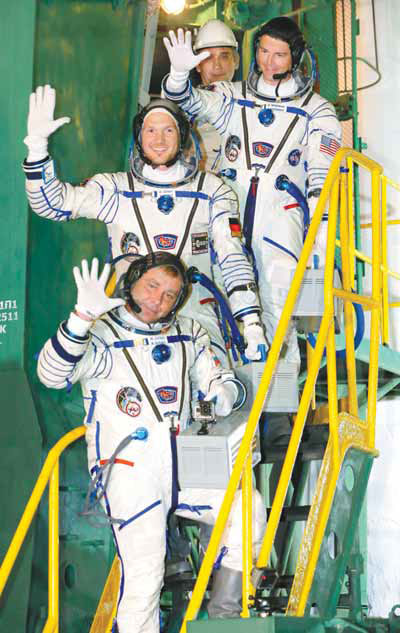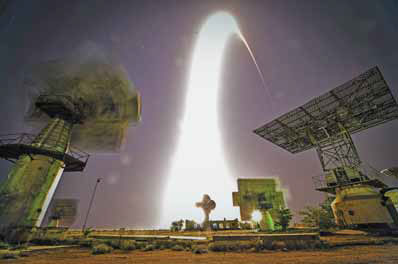Three-man crew docks successfully at space lab
Russian, US astronauts hug when asked about tensions over Ukraine
A Russian spacecraft carrying a three-man crew docked successfully at the International Space Station on Thursday following a flawless launch.
The Soyuz craft, carrying NASA's Reid Wiseman, Russian cosmonaut Max Surayev and Alexander Gerst of the European Space Agency, arrived at the station without incident. They lifted off just under six hours before from the Baikonur cosmodrome in Kazakhstan.
Moscow's mission controllers congratulated the trio on their successful docking.
They are joining US astronaut Steve Swanson and Russians Alexander Skvortsov and Oleg Artemyev, who have been at the station since March.
The Russian and US space agencies have continued to cooperate despite friction between the two countries over Ukraine. NASA depends on the Russian spacecraft to ferry crews to the space station and pays Russia nearly $71 million per seat.
Until last year, Russian spacecraft traveled two days to reach the station. This is only the fifth time that a crew has taken the six-hour "fast-track" route. After the previous launch, in March, the crew ended up taking the longer route because of a software glitch.
The three cosmonauts opened the hatch into the station after two hours, Russian mission control said on its website.
Grinning broadly, the newcomers hugged the crew of three already on board the orbiting laboratory.
The new crew members' mission is scheduled to last 167 days, with a return to Earth in November.
Surayev, 42, is on his second lengthy space station mission after his maiden voyage in 2009, when he became the first Russian space blogger. Wiseman and Gerst, who are both 38, are on their first space mission.
During a news conference on Wednesday, the crew was asked whether the current tensions between Russia and the West over Ukraine would affect their relationship. They responded by hugging each other.
Since the retirement of the US space shuttle in 2011, NASA has been wholly reliant on Russia for delivering astronauts to the space station using its tried-and-trusted Soyuz launch and capsule system.
Moscow has hinted that it may turn down Washington's request to extend the lifespan of the laboratory by four years through 2024.
Russian Deputy Prime Minister Dmitry Rogozin, who oversees the space sector, said this month that Russia will only need the station until 2020. Russia wants to use its resources on "more promising projects", he said.
NASA cut ties with Russia last month as a result of Moscow's role in Ukraine, except for cooperation related to the space station.
"Given Russia's ongoing violation of Ukraine's sovereignty and territorial integrity, NASA is suspending the majority of its ongoing engagements with the Russian Federation," NASA said in a statement.
Rogozin responded derisively by suggesting that NASA might have to use a "trampoline" to send its astronauts to the orbiting lab.
In all, 16 countries participate in the International Space Station program, although the US and Russia provide most of the funding.
AFP-AP
|
US astronaut Reid Wiseman (top), European Space Agency's German astronaut Alexander Gerst (center) and Russian cosmonaut Maxim Surayev wave as they board the Soyuz TMA-13M. Dmitry Lovetsky / Agence France-Presse |
|
Russia's Soyuz TMA-13M spacecraft carrying a crew bound for the International Space Station blasts off at Russian-leased Baikonur cosmodrome in Kazakhstan on Thursday. Kirill Kudrayvtsev / Agence France-Presse |
(China Daily 05/30/2014 page10)
















